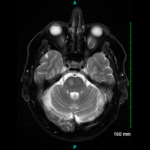Just as meteorologists use their technological tools to try to predict future weather patterns, rheumatologists are increasingly investigating how imaging can be used as a biomarker of GCA disease activity. Grayson and colleagues have conducted a study in 56 patients with large-vessel vasculitis and 59 comparator subjects (individuals with hyperlipidemia, diseases that mimic large-vessel vasculitis and healthy controls) in which FDG-PET imaging studies were conducted at six-month intervals.1 This study demonstrated that a qualitative summary score based on global arterial FDG uptake could be used to predict clinical relapse over a median follow-up period of 15 months. Such a finding is very helpful to the rheumatologist seeking to forecast which GCA patients may flare over time.
Interestingly, FDG-PET scans were interpreted as showing active disease in 41 of 71 large-vessel vasculitis patients in clinical remission, perhaps indicating that this modality can show subclinical phenomena not readily apparent to the clinician at the bedside.
Complications
The topic of GCA is not without rain and thunderstorms, and unfortunate adverse outcomes exist that rheumatologists should think about routinely. Among these are infections, venous thrombosis and blindness. The risk of infection is greatest for patients in the first six to 12 months after diagnosis, and risk factors for infection include advanced age, diabetes and dose and duration of corticosteroid therapy.
Venous thromboembolism has been reported in up to 6% of GCA patients in some studies, with a five-month median duration between GCA diagnosis and thromboembolic event, and a median prednisone dose of 17 mg/day at the time of the event. The potential for blindness is perhaps the best known and most feared complication in GCA. Yates and colleagues compared 34 GCA patients who developed blindness at six months with 399 who did not develop blindness at six months and found peripheral vascular disease, diabetes and history of stroke at a statistically significantly higher prevalence in the former than in the latter group.2
Blue Skies Ahead
In closing the talk, Dr. Manno discussed the reason rheumatologists should see rays of sunshine through the clouds. She was referring to the Giant-Cell Arteritis Actemra (GiACTA) trial, published this past year in the New England Journal of Medicine.3
In this phase 2, randomized, placebo-controlled study from Stone and colleagues, 251 patients with GCA were randomized to one of four groups: 1) weekly tocilizumab (Actemra) with a 26-week prednisone taper, 2) every other week tocilizumab with a 26-week prednisone taper, 3) weekly placebo with a 26-week prednisone taper, and 4) weekly placebo with a 52-week prednisone taper.

